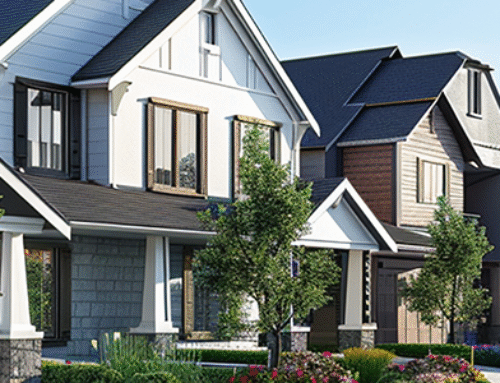The residential construction market continues to shift, offering both opportunities and risks for luxury homebuilders. While some regions are thriving, others are showing signs of vulnerability—and knowing the difference is key to building smart.
This article breaks down the four core indicators of market health and provides real-world strategies for builders operating in different economic climates. Whether building custom estates in booming counties or adjusting price points in riskier areas, high-end builders can stay profitable by remaining data-aware and flexible.
Regional Shifts: A Tale of Two Markets
New research analyzing 572 U.S. counties shows the market isn’t uniform. Here’s the breakdown:
- High-risk areas: Some coastal counties in California and New Jersey are seeing affordability strain, job market weaknesses, and rising foreclosure concerns.
- Stable areas: Many Southern and Midwestern counties—like those in Tennessee and Wisconsin—are performing strongly, with low foreclosure rates and robust job growth.
🛠 What This Means for Builders:
- Local market knowledge is critical. Don’t assume national trends apply to your region.
- Builders in healthy markets can focus on growth and premium offerings.
- Builders in risk-prone markets may need to adjust prices, diversify projects, or limit speculative builds.
🔵 BPA Tool: Map Your Risk Exposure
The Business Plan of Actions (BPA) uses market and business data to help builders calibrate growth, pricing, and product types based on local economic signals.
Start your BPA here →
The Four Indicators Every Builder Should Watch
1. Affordability Pressure
- Nationally, a median-priced home requires about 33% of average wages.
- But in 59% of counties, buyers need even more—in some places, over 50% of their income.
🔍 Builder Insight: In high-cost areas, buyers have less financial flexibility. Consider:
- Offering more compact luxury models
- Providing creative financing or upgrades as incentives
- Building in slightly less expensive adjacent markets
2. Home Equity Health
- Just 2.8% of U.S. homes are seriously underwater.
- Some markets (e.g., parts of Louisiana) have 10%+ underwater mortgages.
🔍 Builder Insight: Strong equity = more move-up buyers. Weak equity = fewer buyers for new construction. In soft equity zones:
- Monitor resale activity carefully
- Offer value-driven models to entice cautious homeowners
3. Foreclosure Rates
- National foreclosure rate: 1 in 1,515 homes
- Some counties: 3x higher (about 1 in 500 homes)
🔍 Builder Insight: High foreclosure rates flood the market with distressed sales. Builders should:
- Avoid speculative construction in distressed zip codes
- Focus on pre-sold or custom homes until stability returns
4. Employment Strength
- U.S. unemployment in March 2025: 4.3%
- Top-performing counties: under 3%, e.g., Rutherford County, TN: 2.6%
🔍 Builder Insight: Strong local job markets support luxury home sales. Builders in these areas can:
- Expand with confidence
- Invest in premium design features and larger projects
Real-World Scenarios
🔨 Example 1: Expansion in a Stable Market
A custom builder in Rutherford County, TN (low unemployment, low foreclosure) successfully launched a luxury subdivision. With high buyer confidence and stable income levels, sales remained strong—even at premium price points.
🧱 Example 2: Adapting in a Risk-Prone Market
A coastal builder in a county with high affordability stress shifted strategy. They introduced smaller luxury homes and flexible financing options, which helped widen their buyer pool and keep projects moving.
🔵 BPA Tool: Align Product with Buyer Budgets
The BPA benchmarks local affordability against your price points, helping you design offerings that sell faster without undercutting margin.
Access your BPA →
Strategies for Growth and Resilience
✅ In Strong Markets:
- Double down on growth.
- Launch new high-end developments.
- Emphasize value-added design features (outdoor kitchens, high-performance HVAC, smart home tech).
⚠️ In Vulnerable Markets:
- Watch local data closely—track foreclosures and jobless rates.
- Prioritize custom builds over speculative projects.
- Adjust pricing and designs to improve affordability without sacrificing quality.
- Diversify across multiple regions to reduce exposure.
Key Takeaways for High-End Builders
- Local conditions matter more than national trends.
- Monitor affordability, equity, foreclosures, and employment to guide strategy.
- Builders in healthy markets can lean into growth.
- Builders in fragile markets should focus on resilience and buyer flexibility.
🔵 Local Insight + Strategic Planning = Resilient Growth
Today’s market is a mosaic—some regions are booming, others are tightening. For high-end builders, success lies in staying alert to four key indicators—affordability, equity, foreclosures, and employment—and building with flexibility in mind.
The Business Plan of Actions (BPA) provides a tailored roadmap to adapt pricing, product mix, and project volume with precision. It’s not just useful for general contractors—trades and subcontractors who receive a BPA can become stronger partners, helping your entire build cycle run smoother.
📍 Whether expanding in stable markets or adapting in tighter ones, now is the time to equip your team—and your trade partners—with a strategic edge.
👉 Start Your BPA →





